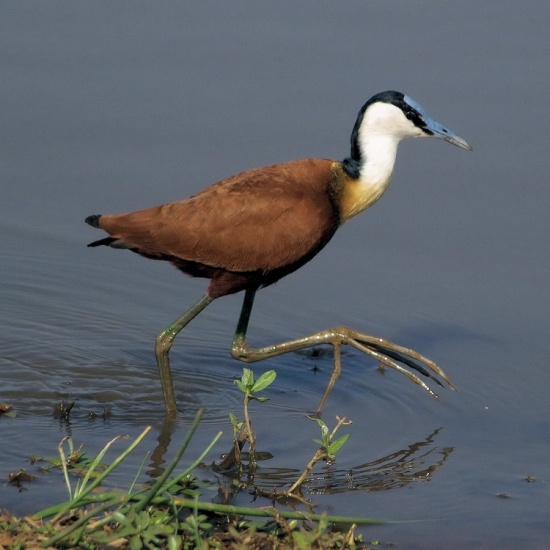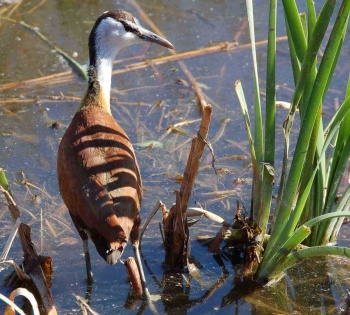(Imp sizes. Diet. References updated) |
|||
| (22 intermediate revisions by 6 users not shown) | |||
| Line 1: | Line 1: | ||
| − | + | [[Image:African_Jacanaa.jpg|thumb|550px|right|Photo by {{user|CollinBax|CollinBax}}<br />Lowersabie, [[Kruger National Park]], [[South Africa]], August 2008]] | |
| − | [[Image: | + | ;[[:Category:Actophilornis|Actophilornis]] africanus<br /> |
| − | + | ''Actophilornis africana'' | |
==Identification== | ==Identification== | ||
| − | + | 23–31 cm (9-12¼ in), mass 115-274 g<br /> | |
| − | + | '''Adult:''' | |
| − | + | *Chestnut upperparts with black wingtips, rear neck and eyestripe | |
| − | + | *White underparts | |
| − | + | *Chestnut belly patch | |
| − | + | *Blue bill extends up as a coot-like head shield | |
| + | *Legs and very long toes are grey | ||
| + | *Eyes are dark brown<br /> | ||
| + | Sexes alike but the females are larger than males | ||
| + | ====Similar Species==== | ||
| + | '''Immature:''' is similar to adult [[Lesser Jacana]], but much bigger; above light brown (dark brown in adult Lesser Jacana), below white; breast washed golden (no gold in adult Lesser Jacana); flanks brown; frontal shield small (not visible in field); crown and hind neck blackish brown (crown rufous in adult Lesser Jacana); black line through eye; buff eyebrow (eyebrow of adult Lesser Jacana white, forehead buff). | ||
| + | [[Image:African Jacana Juvanile.jpg|thumb|350px|right|Juvenile <br />Photo by {{user|JohnathanAKR|JohnathanAKR}}<br />[[Kruger National Park]], [[South Africa]], August 2007]] | ||
==Distribution== | ==Distribution== | ||
| − | + | Widespread thoughout sub-Saharan [[Africa]]<br /> | |
| + | '''Western Africa''': [[Mauritania]], [[Senegambia]], [[Senegal]], The [[Gambia]], [[Guinea-Bissau]], [[Guinea]], [[Mali]], [[Sierra Leone]], [[Liberia]], [[Ivory Coast]], [[Burkina Faso]], [[Ghana]], [[Togo]], [[Benin]], [[Nigeria]], [[Niger]], [[Chad]], [[Cameroon]], [[Central African Republic]], [[Equatorial Guinea]], [[Gabon]], [[Congo]] and [[Angola]]<br /> | ||
| + | '''Eastern Africa''': [[Sudan]], [[Ethiopia]], [[Djibouti]], [[Somalia]], [[Kenya]], [[Uganda]], [[Rwanda]], [[Burundi]], [[Tanzania]], [[Zanzibar]], [[Zambia]], [[Mozambique]] and [[Malawi]]<br /> | ||
| + | '''Southern Africa''': [[Namibia]], [[Botswana]], [[Zimbabwe]], [[South Africa]], [[KwaZulu-Natal]], [[Lesotho]] and [[Swaziland]]<br /> | ||
| + | '''African Islands''': Saint Helena and [[Madagascar]] | ||
==Taxonomy== | ==Taxonomy== | ||
| + | This is a [[Dictionary_M-O#M|monotypic]] species<sup>[[#References|[1]]]</sup>. | ||
| + | |||
==Habitat== | ==Habitat== | ||
| + | Lagoons, lakes, pans, river backwaters; usually with fringing vegetation and floating water lilies, Polygonum and other water plants. | ||
==Behaviour== | ==Behaviour== | ||
| − | The | + | The Jacanas are a group of waders in the order [[:Category:Charadriiformes|Charadriiformes]]. Their huge feet and claws enable them to walk on floating vegetation in the shallow lakes that are their preferred habitat. |
| − | + | ====Diet==== | |
| + | Their diet consists mostly of insects and worms, with other arthropods such as spiders and crustaceans. | ||
| + | ====Breeding==== | ||
| + | It lays four black-marked brown eggs in a floating nest. A polyandrous species. The males, as in some other wader families like the phalaropes, take responsibility for incubation. | ||
| + | ====Movements==== | ||
| + | It is sedentary apart from seasonal dispersion. | ||
| − | + | ==References== | |
| + | #{{Ref-Clements6thAug17}}#Avibase | ||
| + | #Animal Pictures Archive | ||
| + | {{ref}} | ||
| + | ==External Links== | ||
| + | {{GSearch|Actophilornis+african}} | ||
| + | <br /> | ||
| + | {{Video|African_Jacana}} | ||
| − | + | [[Category:Birds]][[Category:Actophilornis]] [[Category:Videos]] | |
| − | |||
| − | |||
| − | [[Category: | ||
Revision as of 23:03, 30 December 2017
- Actophilornis africanus
Actophilornis africana
Identification
23–31 cm (9-12¼ in), mass 115-274 g
Adult:
- Chestnut upperparts with black wingtips, rear neck and eyestripe
- White underparts
- Chestnut belly patch
- Blue bill extends up as a coot-like head shield
- Legs and very long toes are grey
- Eyes are dark brown
Sexes alike but the females are larger than males
Similar Species
Immature: is similar to adult Lesser Jacana, but much bigger; above light brown (dark brown in adult Lesser Jacana), below white; breast washed golden (no gold in adult Lesser Jacana); flanks brown; frontal shield small (not visible in field); crown and hind neck blackish brown (crown rufous in adult Lesser Jacana); black line through eye; buff eyebrow (eyebrow of adult Lesser Jacana white, forehead buff).
Distribution
Widespread thoughout sub-Saharan Africa
Western Africa: Mauritania, Senegambia, Senegal, The Gambia, Guinea-Bissau, Guinea, Mali, Sierra Leone, Liberia, Ivory Coast, Burkina Faso, Ghana, Togo, Benin, Nigeria, Niger, Chad, Cameroon, Central African Republic, Equatorial Guinea, Gabon, Congo and Angola
Eastern Africa: Sudan, Ethiopia, Djibouti, Somalia, Kenya, Uganda, Rwanda, Burundi, Tanzania, Zanzibar, Zambia, Mozambique and Malawi
Southern Africa: Namibia, Botswana, Zimbabwe, South Africa, KwaZulu-Natal, Lesotho and Swaziland
African Islands: Saint Helena and Madagascar
Taxonomy
This is a monotypic species[1].
Habitat
Lagoons, lakes, pans, river backwaters; usually with fringing vegetation and floating water lilies, Polygonum and other water plants.
Behaviour
The Jacanas are a group of waders in the order Charadriiformes. Their huge feet and claws enable them to walk on floating vegetation in the shallow lakes that are their preferred habitat.
Diet
Their diet consists mostly of insects and worms, with other arthropods such as spiders and crustaceans.
Breeding
It lays four black-marked brown eggs in a floating nest. A polyandrous species. The males, as in some other wader families like the phalaropes, take responsibility for incubation.
Movements
It is sedentary apart from seasonal dispersion.
References
- Clements, J. F., T. S. Schulenberg, M. J. Iliff, D. Roberson, T. A. Fredericks, B. L. Sullivan, and C. L. Wood. 2017. The eBird/Clements checklist of birds of the world: v2017, with updates to August 2017. Downloaded from http://www.birds.cornell.edu/clementschecklist/download/
- Avibase
- Animal Pictures Archive
Recommended Citation
- BirdForum Opus contributors. (2024) African Jacana. In: BirdForum, the forum for wild birds and birding. Retrieved 18 April 2024 from https://www.birdforum.net/opus/African_Jacana
External Links





